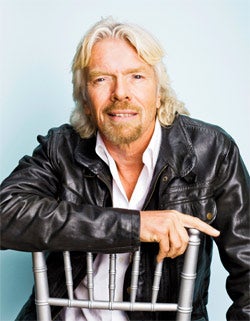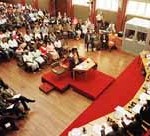by Charles Plant | Sep 27, 2012 | Leaders

Thinking Strategically (yesterday’s blog), in more prosaic terms is about seeing the big picture. What’s your big picture? For Richard Branson, it was customer service. He built the Virgin Group, a collection of seemingly unrelated businesses by targeting businesses where things were not being run well by other people.
From his first entrepreneurial venture at the age of 16 to his current big picture idea of Virgin Galactic, Branson has seen niches where others have chosen not to go or as in the case of Virgin Airways, where he was frustrated by current service levels. He founded Virgin Records because no one would produce and release Mike Oldfield’s hypnotic Tubular Bells. He founded Virgin Atlantic because American Airlines canceled a flight to the Virgin Islands.
“There is no point in going into a business unless you can make a radical difference in other people’s lives,” Branson says. “To me, it’s like painting a picture: You have to get all the colors right and all the little nuances right to create the perfect picture, or the perfect company. I know that there’s need for Virgin to come in and attack a marketplace, because I know that I’m frustrated by having to experience bad service in that particular marketplace.” (www.entrepreneur.com)
So frustration leads to big picture leads to another company. If you look at all of his business startups, he was attacking markets where he saw some combination of substandard quality mixed with high cost or slow service. For Branson, the big picture is all about changing the current paradigm of Quality, Cost, and Speed.
by Charles Plant | Sep 17, 2012 | Leaders
 Today is the first anniversary of the day that Occupy Wall Street took over Zuccotti Park and the Occupy Movement was born. As a movement it began over a growing disillusionment about income inequality and corporate greed. While it dominated the world’s attention for many weeks, its impact was short lived. Eventually it lost its momentum, its ability to organize, and was broken up.
Today is the first anniversary of the day that Occupy Wall Street took over Zuccotti Park and the Occupy Movement was born. As a movement it began over a growing disillusionment about income inequality and corporate greed. While it dominated the world’s attention for many weeks, its impact was short lived. Eventually it lost its momentum, its ability to organize, and was broken up.
What doomed the movement was its lack of leadership. Not only did a credible leader not emerge but in fact the movement resisted any attempts by individuals who wanted to lead it. “Without leaders or specific demands, what started as a protest against income inequality turned into an amorphous protest against everything wrong with the world.” (Washington Times”)
Movements and groups need leaders. Where would the civil rights movement have been without Martin Luther King, the feminist movement without Germaine Greer?
Without a leader, there was no one to articulate a vision. Without a leader there was no one to focus communications. And without a leader, there was no one left to motivate followers when the parks had been emptied.
Income inequality still exists. Corporate greed still exists. The disenfranchised still need a voice. The movement needs leadership.
by Charles Plant | Sep 5, 2012 | Leaders
 I bet you know who invented the telephone. How about the light bulb? If you’re Canadian, you know who invented insulin because that may be the last time something that useful was invented here. (I’m sure I’ll get hate mail for that comment.) How about Email? Do you know who invented it? I must admit that I didn’t know. Such a shame since it’s reach is worldwide and the frequency of its use surely would qualify it as a pandemic.
I bet you know who invented the telephone. How about the light bulb? If you’re Canadian, you know who invented insulin because that may be the last time something that useful was invented here. (I’m sure I’ll get hate mail for that comment.) How about Email? Do you know who invented it? I must admit that I didn’t know. Such a shame since it’s reach is worldwide and the frequency of its use surely would qualify it as a pandemic.
Here are some stats on its use from the Radacati Group
- 107 trillion – The number of emails sent on the Internet in 2010.
- 294 billion – Average number of email messages per day.
- 1.88 billion – The number of email users worldwide.
- 2.9 billion – The number of email accounts worldwide.
So there are all sorts of claims as to who actually invented it. The answer depends on how you define email.
Tom Van Vleck
The first attempt at something like email was back in the mid 60s on MIT’s Compatible Time-Sharing System (CTSS). Tom Van Vleck developed a “mail” command that let users send electronic messages to other users of the same system. No networking and no mail system but it was a useful start.
Ray Tomlinson
In 1971, Ray Tomlinson built a messaging system atop ARPAnet, the research network funded by the US Department of Defense that would eventually give rise to the internet. Ray’s system sent electronic messages between machines. Messages now, but no application. It was recognized in 1977 that no attempt was being made to emulate a full-scale, inter-organizational mail system.
V.A. Shiva Ayyadurai
Then in 1978 V.A. Shiva Ayyadurai,a 14-year-old working in Newark, NJ built and copyrighted a software program called “email”. This was the first program to structure electronic communications in a way that mimicked paper mail with “inboxes” and “outboxes” and “address books.” Ayyadurai who is now a lectureer at MIT was at the tender age of 14, working at the University of Medical and Dentistry of New Jersey.
You can check out his claim at www.inventorofemail.com/
And yes, that invention that you probably hate but can’t live without was invented by a 14 year old.
by Charles Plant | Aug 30, 2012 | Leaders, Leadership Development

You have probably heard of or perhaps even volunteered for Habitat for Humanity. Its history is one of a personal vision that became a worldwide reality. The concept began in 1942, when a farmer and scholar by the name of Clarence Jordan, founded a small community outside of Americus, Georgia. He called it Koinonia Farm.
In 1965, Millard and Linda Fuller visited the community having recently left a successful business and an affluent lifestyle in Montgomery, Alabama. Their vision was to begin a new life of service to mankind. At Koinonia, Jordan and Fuller developed the concept of “partnership housing.” The idea was those in need of adequate shelter could work side by side with volunteers to build simple, decent houses.
The Fullers decided to apply the concept in developing countries when they moved to Zaire in 1973. After three years of hard work to launch a successful house building program, they returned to the United States.
The little idea grew and the Fullers founded the Habitat for Humanity movement in 1976. The movement set out to build houses at no profit and charge no interest on loans needed to build them. The fund’s money would come from the new homeowners’ house payments, no-interest loans provided by supporters and money earned by fund-raising activities.
“Since 1976, Habitat for Humanity International has built, rehabilitated, repaired or improved more than 500,000 houses worldwide – providing shelter for more than 2 million people.”
by Charles Plant | Aug 15, 2012 | Leaders, Leadership Development
 Perhaps the greatest modern example of “Forgive and Forget” is South Africa’s Truth and Reconciliation Commission.
Perhaps the greatest modern example of “Forgive and Forget” is South Africa’s Truth and Reconciliation Commission.
This was a court-like body assembled in South Africa after the abolition of apartheid. Individuals who were identified as victims of gross human rights violations were able to give statements about their experiences in a public venue. Those who had violated their rights could also testify and request amnesty from civil and criminal prosecution.
One important aspect of the Commission is that while it sought to forgive, it didn’t seek to forget. To forget would have been to sweep all past wrongs under the rug without a hearing. By holding the Commission is was possible to preserve the memories of wrong doing so as to serve of an example of what not to do again. Despite some flaws, and inevitable criticism it is generally acknowledged to have been successful.
This one process was essential for South Africa to move beyond the sins of apartheid and showed a whole new dimension of leadership to the world.
by Charles Plant | Aug 9, 2012 | Leaders, Leadership Development
 Soichiro Honda didn’t start out to develop one of the largest and most successful automotive companies in the world. All he really wanted to do was to develop a better type of piston to improve car performance.
Soichiro Honda didn’t start out to develop one of the largest and most successful automotive companies in the world. All he really wanted to do was to develop a better type of piston to improve car performance.
His first attempt to commercialize his improved pistons was to offer his designs to Toyota. He was turned down quickly as their engineers didn’t even meet with him. This is where resilience came in. Not being daunted by his initial failure, he persisted and eventually did meet with Toyota, only to have them ridicule his designs. He picked himself up again and persisted, going into great detail to convince them. Finally, he obtained an order to supply pistons to Toyota.
With an order in hand, Honda threw everything he had, money, knowledge and experience into building a plant to produce these new pistons. His new plant was quickly destroyed by an earthquake.
He picked himself up again and proceeded to build another plant which was just completed as World War II erupted. The war eventually devastated the country and with it, Honda’s plant. He had lost his factory, his money, and many of his friends but he started again. The rest is history.
Honda had the resilience to persevere in spite of numerous setbacks that would have destroyed a less resilient individual.






